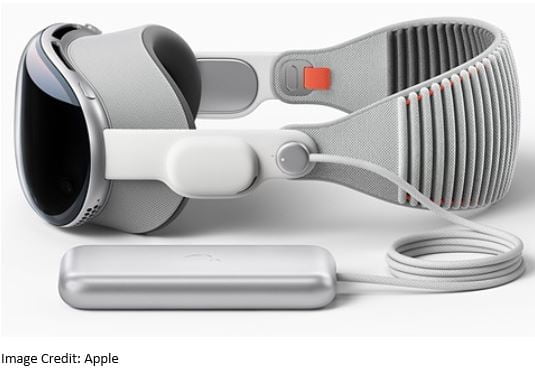Apple Vision Pro blends digital content with your physical space
You need not need your phone screen or monitor to watch and operate the content and menus and options, based on Apple’s vision OS the spatial operating system, this is radically different from the conventional way of operating phones and computers, this is based on the technologies of Virtual reality and Augmented reality.
How much does the Apple Vision Pro cost?
Apple Vision Pro: $3499 available early 2024
What is Augmented Reality?
Augmented reality (AR) is a technology that superimposes a computer-generated image on a user’s view of the real world, thus providing a composite view. AR can be used to enhance the user’s experience of a real-world environment, such as by providing additional information or instructions.
AR is becoming increasingly popular, with applications in a variety of industries, including gaming, manufacturing, and education. For example, AR can be used to create interactive gaming experiences, provide real-time instructions to workers, or help students learn about historical events.
As AR technology continues to develop, it is likely to become even more widespread and have a significant impact on our lives.
Here are some of the benefits of augmented reality:
Enhanced user experience: AR can enhance the user’s experience of a real-world environment by providing additional information or instructions. For example, AR can be used to provide tourists with information about historical landmarks or to help students learn about scientific concepts.
Improved productivity: AR can help workers to be more productive by providing them with real-time instructions or by helping them to visualize complex data. For example, AR can be used by surgeons to guide them during surgery or by engineers to design new products.
Increased engagement: AR can help to increase engagement by making learning and experiences more interactive and immersive. For example, AR can be used to create interactive games or to provide virtual tours of historical sites.
Here are some of the challenges of augmented reality:
Hardware limitations: AR requires specialized hardware, such as head-mounted displays or smartphones with special AR capabilities. This can make AR more expensive and less accessible than other technologies.
Software limitations: The software for AR is still in its early stages of development, which can limit the functionality and usability of AR applications.
Privacy concerns: Some people are concerned about the privacy implications of AR, as it could be used to track users’ movements or collect data about their environment.
Despite these challenges, augmented reality is a promising technology with the potential to revolutionize the way we interact with the world around us.
What is Virtual Reality Technology?
Virtual reality (VR) is a computer-generated environment that can be experienced by a user as if they were actually there. VR systems typically include a headset with a screen that displays the virtual environment and motion-tracking sensors that allow the user to interact with the environment. Virtual reality technology Opens in a new window
VR has a wide range of potential applications, including gaming, training, education, and entertainment. For example, VR can be used to train surgeons on complex procedures or to help students learn about different historical periods. VR can also be used to create immersive and engaging entertainment experiences.
VR is still a relatively new technology, but it is rapidly developing. As VR technology continues to improve, it is likely to become more widely used in a variety of fields.
Here are some of the benefits of virtual reality:
Immersive experience: VR can provide users with an immersive experience that can be very realistic and engaging. This can be beneficial for a variety of applications, such as training, education, and entertainment.
Increased productivity: VR can help to increase productivity by providing workers with a more realistic and interactive training environment. This can lead to faster learning and better performance.
Reduced costs: VR can help to reduce costs by eliminating the need for travel and physical training environments. This can be especially beneficial for businesses that need to train large numbers of employees.
Here are some of the challenges of virtual reality:
Hardware limitations: VR requires specialized hardware, such as headsets and motion-tracking sensors. This can make VR more expensive and less accessible than other technologies.
Software limitations: The software for VR is still in its early stages of development, which can limit the functionality and usability of VR applications.
Motion sickness: Some people experience motion sickness when using VR. This can be caused by the mismatch between the visual information that the user is seeing and the vestibular information that their body is feeling.
Despite these challenges, virtual reality is a promising technology with the potential to revolutionize the way we interact with the world around us


